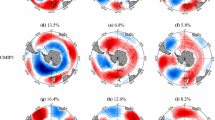Abstract
The last 810 years of a control integration with the ECHAM1/LSG coupled model are used to clarify the nature of the ocean-atmosphere interactions at low frequencies in the North Atlantic and the North Pacific. To a first approximation, the atmosphere acts as a white noise forcing and the ocean responds as a passive integrator. The sea surface temperature (SST) variability primarily results from short time scale fluctuations in surface heat exchanges and Ekman currents, and the former also damp the SST anomalies after they are generated. The thermocline variability is primarily driven by Ekman pumping. Because the heat, momentum, and vorticity fluxes at the sea surface are correlated in space and time, the SST variability is directly linked to that in the ocean interior. The SST is also modulated by the wind-driven geostrophic fluctuations, resulting in persistent correlation with the thermocline changes and a slight low-frequency redness of the SST spectra. The main dynamics are similar in the two oceans, although in the North Pacific the SST variability is more strongly influenced by advection changes and the oceanic time scales are larger. A maximum covariance analysis based on singular value decomposition in lead and lag conditions indicates that some of the main modes of atmospheric variability in the two oceans are sustained by a very weak positive feedback between the atmosphere, SST, and the strength of the subtropical and subpolar gyres. In addition, in the North Atlantic the main surface pressure mode has a small quasi-oscillatory component at 6-year period, and advective resonance occurs for SST around 10-year period, both periods being also singled out by multichannel singular spectrum analysis. The ocean-atmosphere coupling is however much too weak to redden the tropospheric spectra or create anything more than tiny spectral peaks, so that the atmospheric and oceanic variability is dominated in both ocean sectors by the one-way interactions.
Similar content being viewed by others
Author information
Authors and Affiliations
Additional information
Received: 2 April 1999 / Accepted: 14 October 1999
Rights and permissions
About this article
Cite this article
Frankignoul, C., Kestenare, E., Sennéchael, N. et al. On decadal-scale ocean-atmosphere interactions in the extended ECHAM1/LSG climate simulation. Climate Dynamics 16, 333–354 (2000). https://doi.org/10.1007/s003820050332
Issue Date:
DOI: https://doi.org/10.1007/s003820050332




